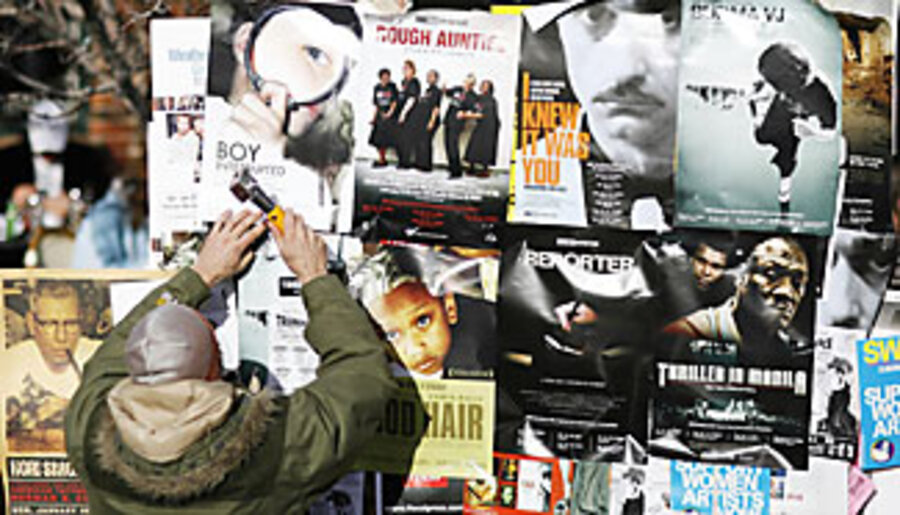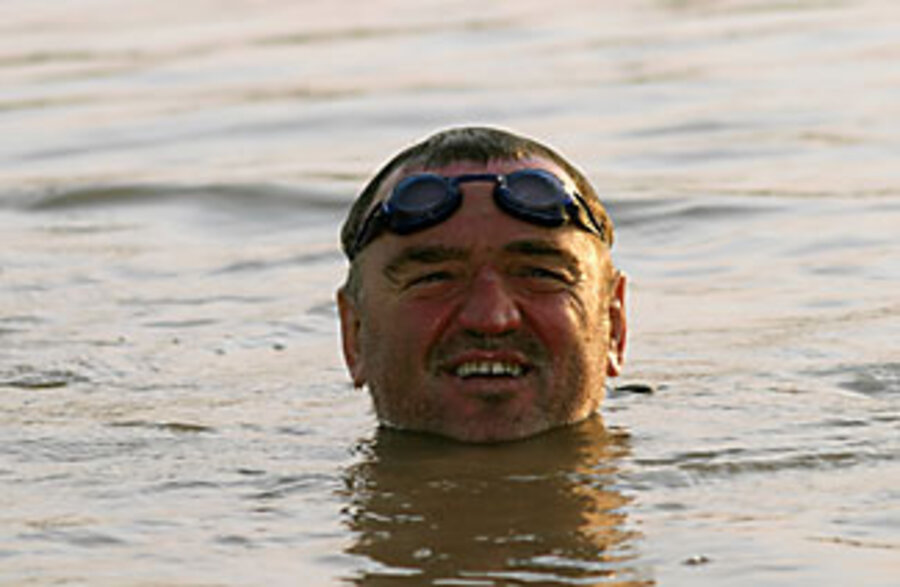Sundance: Take my film ... please!
Loading...
| Park City, Utah
The 25th annual 11-day Sundance film festival premièred Jan. 15 with the Australian claymation feature "Mary and Max," an oddball romance about a pen pal friendship between a chubby, friendless, Melbourne girl and a 44-year-old Manhattan recluse diagnosed with Asperger syndrome. Just another day in the life of America's premier indie-movie beauty pageant.
In the Q-and-A afterward, director Adam Elliott explained that making movies was "like making love and being stabbed to death at the same time." Aspiring auteurs – of which there are jillions this week traipsing up and down the streets of Park City, Utah – please take note.
In the recent past, the Sundance honchos, from founder Robert Redford on down, have attempted to defuse the festival's marketplace madness. (Two years ago buttons emblazoned with "Focus on Film" were proffered to participants.) The madness is still here but the marketplace, given the cratering economy, has slimmed dramatically.
In this year's festival there are a total of 118 features, selected from 3,661 submissions, and many of them, the good as well as the bad, will be orphaned. (I saw 15 of these films in five days.) This is partly because, as a result of the recent gutting of specialty
film divisions like Warner Independent and Paramount Vantage, there are fewer adoptive families out there. But even the remaining big buyers, which include Sony Pictures Classics, Focus, and Fox Searchlight, agree that a new paradigm, a new delivery system that doesn't rely so heavily on theatrical distribution, is essential if small and worthy indies are going to be seen by the audiences who should be seeing them.
Critics often feel frustrated that, with disturbing frequency, movies they champion at film festivals never see the light of day. For the foreseeable future, this frustration will only get worse.
Maybe this is why Sundance is emphasizing its green credentials more than ever this year. At least the environment is something you can do something about right away. So no more bottled water giveaways in the festival venues. Reusable bottles are being provided by festival sponsors to be refilled at "hydration stations." This year's trendy button says "I pledge to reduce bottled water waste." All the while, eco-unfriendly limos unload their high-tech, energy-gobbling equipment on Main Street.
Still, this is the festival that unveiled "An Inconvenient Truth," and eco-themed movies abound. "Dirt! The Movie," directed by Bill Benenson and Gene Rosow, is all about how dirt – you know, the soil beneath you – sustains us. Louie Psihoyos's "The Cove" is about a covert operation, led by the guy who trained the original Flipper, to expose the slaughtering of dolphins in a small Japanese town.
And then there is John Maringouin's "Big River Man," which brings us into the weirdo world of Slovenian Martin Strel, a 50-something overweight party animal who nevertheless, over 66 days, attempts to swim the 3,375-mile length of the Amazon, having already conquered the Mississippi and Yangtze rivers. Not pretty in a wet suit, the beer-loving Strel trumpets his epic swim as a way to draw attention to the destruction of the rain forest. However, what with all the parasites and pythons and alligators, his quest seems more deranged than inspirational. (This is the most Werner Herzogian movie that Werner Herzog never made.) Strel looks catatonic by the end, but I ran into him on the streets of Park City a few days after seeing the film and he was chipper and thinking about new rivers to ramble.
There are those who think that advertising is a form of environmental pollution. Doug Pray's "Art & Copy" begs to differ. The documentary, which starts out drawing a connection between Madison Avenue commercials and prehistoric cave paintings, plays like an advertorial for the advertising industry. Nevertheless, many of the top ad innovators since the 1960s are interviewed, and it's fun re-seeing clips from their famous campaigns – ranging from "I Y NY" to "Just Do It" to "Got Milk?" But the absence of probing questions by Pray, who has made commercials himself, is maddening. (Sample unasked query: Do you ever promote products you dislike?)
Probing questions, however, are rampant in both Liz Garbus's "Shouting Fire: Stories from the Edge of Free Speech," which is about the embattled history of First Amendment rights, and Greg Barker's "Sergio," about the United Nations diplomat and High Commissioner for Human Rights, Sergio Vieira de Mello, who was killed in a truck bombing in Iraq in 2003 (in a war he disapproved of).
Garbus is the daughter of famed First Amendment lawyer Martin Garbus, who is extensively interviewed in "Shouting Fire." To its credit, the film exposes free speech intolerance both on the left (for example, a Christian schoolboy is suspended for wearing a Bible-quoting T-shirt condemning homosexuality) and the right (an Arab-American high school principal, whose son was activated in the National Guard post-9/11, is forced to resign because she discussed the word "intifada" in class).
"Sergio" (which will play on HBO later this year) presents a complex portrait of a man who his biographer, the Pulitzer Prize-winning political historian Samantha Power, describes in the film as a "cross between James Bond and Bobby Kennedy." His 34 years in the UN included negotiating with the Khmer Rouge to repatriate 400,000 Cambodian refugees and brokering the independence of East Timor from Indonesia.
Two boxing-themed documentaries were about much more than boxing. John Dower's "Thriller in Manila," which will also be broadcast on HBO, centers on the three famous fights in the 1970s between Muhammad Ali and Joe Frazier. The legendary and intensely bitter rivalry is presented from Frazier's point of view. Living in a cramped room in the rundown gym he operates in Philadelphia, Frazier can't let go of his hatred for Ali, who publicly called him a "gorilla" and an Uncle Tom. This from a man, who, the movie reveals, once spoke at a rally for the Ku Klux Klan as a member of the Nation of Islam and touted the separation of the black and white races.
James Toback's "Tyson" offers up a rise-and-fall portrait of the troubled former heavyweight champion Mike Tyson primarily utilizing his own words, which are often agonizingly revelatory. Tyson's streetwise ruminations and recriminations will come as a surprise only to those people who think that boxers are, by definition, lugs. After the public screening of the film, Tyson reacted warily to the profuse applause, as if he was being set up for a sucker punch. He is afraid the good-time vibes will trigger a relapse. "I use drugs when I'm successful, not when I'm down," he said. "This is very intimidating."
If I am emphasizing documentaries here it is only because the dramatic films I saw were generally less compelling. Not much is going on in the vapidly pleasant romantic comedy "500 Days of Summer" except for the pleasure of being in Zooey Deschanel's company for 90 minutes. "Motherhood," starring Uma Thurman as a harried mom, is cutesy. The interminable "Moon" stars Sam Rockwell as a lunar-based astronaut who encounters his own clone. That's two Sam Rockwells too many. John Krasinski's writing-directing debut "Brief Interviews with Hideous Men," based on the book by the late David Foster Wallace, is like a David Mamet play without the bilious eloquence.
Maybe it was because of the impending inauguration of Barack Obama, but, when it came to movies here in Park City, I kept coming back to race. Paul Saltzman's fine documentary "Prom Night in Mississippi" tells about the first integrated prom in the history of Charleston high school – in 2008. (The school board accepted the offer of Morgan Freeman, a Charleston resident, to pay for the prom on the condition that it be colorblind.) Not long after I saw this film I watched the swearing in of President Obama. The festival had set up two large outdoor TV screens and a loudspeaker in lower Main Street, and hundreds of us stood there watching in the cold. It was the best movie I saw at Sundance.






